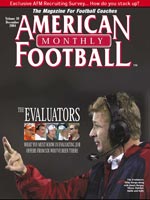AMERICAN FOOTBALL MONTHLY THE #1 RESOURCE FOR FOOTBALL COACHES
Article CategoriesAFM Magazine
|
The Spread Shot-Wing OffenseA variation of the Delaware Wing T can provide instant offenseby: Lew Johnston © More from this issue For years, we were a basic Delaware Wing T football team. We had great success with it, using the 3 basic series (buck sweep/trap; belly/down and power) and mixing in a good dose of play action and 3 step drop-back passes to keep defenses honest. But four years ago we started a 15 year old freshman at quarterback whom we knew was going to be somebody special as far as throwing the football before he graduated. He broke our area’s 40 year old record for career passing yards midway through his senior year. He was the classic drop-back pocket passer with decent running ability. I realized then that we had a weapon that people would be hard-pressed to stop if we opened up our passing....The full article can only be seen by subscribers. Subscribe today!
|
|
|||||||
| HOME |
MAGAZINE |
SUBSCRIBE | ONLINE COLUMNISTS | COACHING VIDEOS |
Copyright 2025, AmericanFootballMonthly.com
All Rights Reserved





